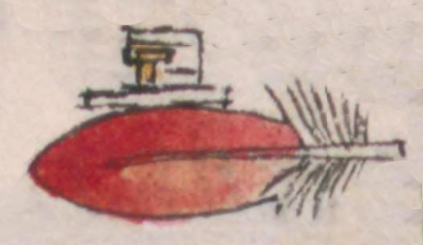chamolin (FCbk8f65v)
This compound hieroglyph for the feather called chamolin comes from the Florentine Codex, Book 9, folio 65 verso. The glyph is spelled with phonetic complementation as cha-CHAMOLIN (with the house glyph for cha, and a red feather logograph for CHAMOLIN).
Allison Caplan
As can be seen in the contextualizing image, this glyph appears in the middle image on the right. It is paired with TZANATL (the black bird logograph just to the left), both of which are the types of red and black feathers used specifically for creating contour lines in feather paintings, as described in the alphabetic text immediately flanking it. See also: Allison Caplan, "So It Blossoms, So It Shines: Precious Feathers and Gold in Pre- and Post-Conquest Nahua Aesthetics," M.A. thesis, Tulane, appendix, 2014, p.139.
Allison Caplan
1577
plumas, feathers, red, rojas, rojo, scarlet, escarlatas, parrots, cotorras, papagayos

chamol(in), a scarlet feather, a feather from a scarlet parrot, https://nahuatl.wired-humanities.org/content/chamolin
tzana(tl), a black bird, the Slender-billed Grackle, https://nahuatl.wired-humanities.org/content/tzanatl
Florentine Codex, World Digital Library and Library of Congress, https://www.loc.gov/resource/gdcwdl.wdl_10620/?sp=134
The Library of Congress is unaware of any copyright or other restrictions in the World Digital Library Collection. Absent any such restrictions, these materials are free to use and reuse. Researchers are encouraged to review the source information attached to each item. If you do publish anything from this database, please cite the Visual Lexicon of Aztec Hieroglyphs.




